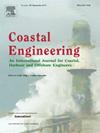Evaluating five shoreline change models against 40 years of field survey data at an embayed sandy beach
IF 4.2
2区 工程技术
Q1 ENGINEERING, CIVIL
引用次数: 0
Abstract
Robust and reliable models are needed to understand how coastlines will evolve over the coming decades, driven by both natural variability and climate change. This study evaluated how accurately five popular ‘reduced-complexity’ models replicate multi-decadal shoreline change at Narrabeen-Collaroy Beach, a sandy embayment in Sydney, Australia. Measured shoreline positions derived from approximately monthly field surveys were used for 20-year calibration and 20-year validation periods. The models performed similarly on average but with large variability between transects. The set-up of several models was modified to compensate for their sensitivity to imperfect input wave data, and further site-specific improvements were identified. Capturing interannual to decadal-scale variability in cross-shore and longshore dynamics at this site was challenging for all five models. Models appeared to aggregate key processes at this timescale into parameter values rather than representing them directly. This suggests time-varying parameters or changes to model structure may be necessary for decadal-scale simulations.
在一个海湾沙滩上用40年的实地调查数据评估五种海岸线变化模型
要了解海岸线在未来几十年将如何在自然变率和气候变化的共同作用下演变,需要稳健可靠的模型。这项研究评估了五种流行的“降低复杂性”模型在澳大利亚悉尼的一个沙质海湾narrabeen - colloy海滩上复制几十年的海岸线变化的准确性。从大约每月一次的实地调查中获得的海岸线位置测量值用于20年的校准和20年的验证期。这些模型的平均表现相似,但在样条之间有很大的差异。对几个模型的设置进行了修改,以补偿它们对不完美输入波数据的敏感性,并确定了进一步的具体改进。捕获该站点的跨海岸和长海岸动态的年际至十年尺度变化对所有五个模式都具有挑战性。模型似乎将这个时间尺度上的关键过程聚合到参数值中,而不是直接表示它们。这表明,对于年代际尺度的模拟,时变参数或模式结构的变化可能是必要的。
本文章由计算机程序翻译,如有差异,请以英文原文为准。
求助全文
约1分钟内获得全文
求助全文
来源期刊

Coastal Engineering
工程技术-工程:大洋
CiteScore
9.20
自引率
13.60%
发文量
0
审稿时长
3.5 months
期刊介绍:
Coastal Engineering is an international medium for coastal engineers and scientists. Combining practical applications with modern technological and scientific approaches, such as mathematical and numerical modelling, laboratory and field observations and experiments, it publishes fundamental studies as well as case studies on the following aspects of coastal, harbour and offshore engineering: waves, currents and sediment transport; coastal, estuarine and offshore morphology; technical and functional design of coastal and harbour structures; morphological and environmental impact of coastal, harbour and offshore structures.
 求助内容:
求助内容: 应助结果提醒方式:
应助结果提醒方式:


